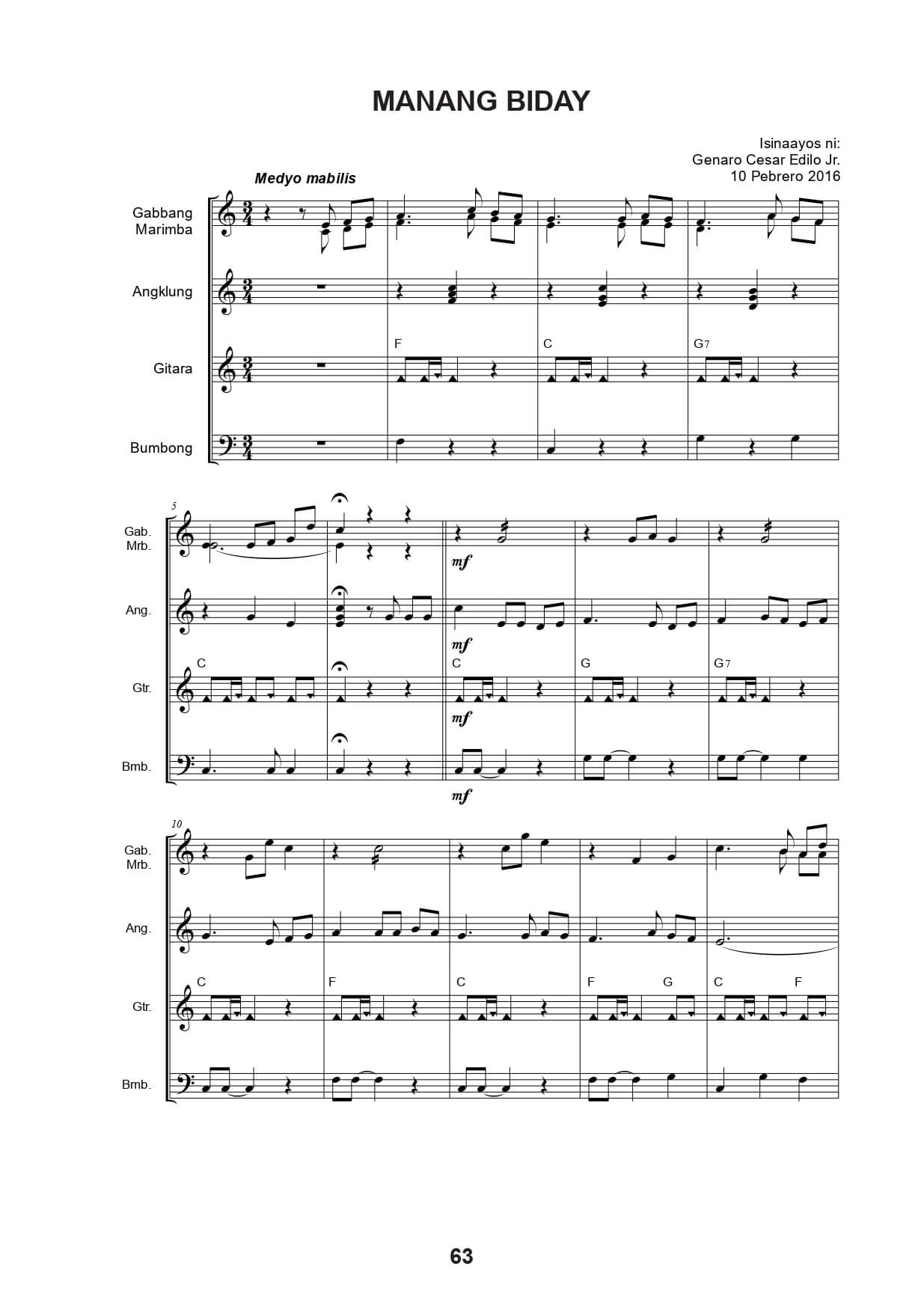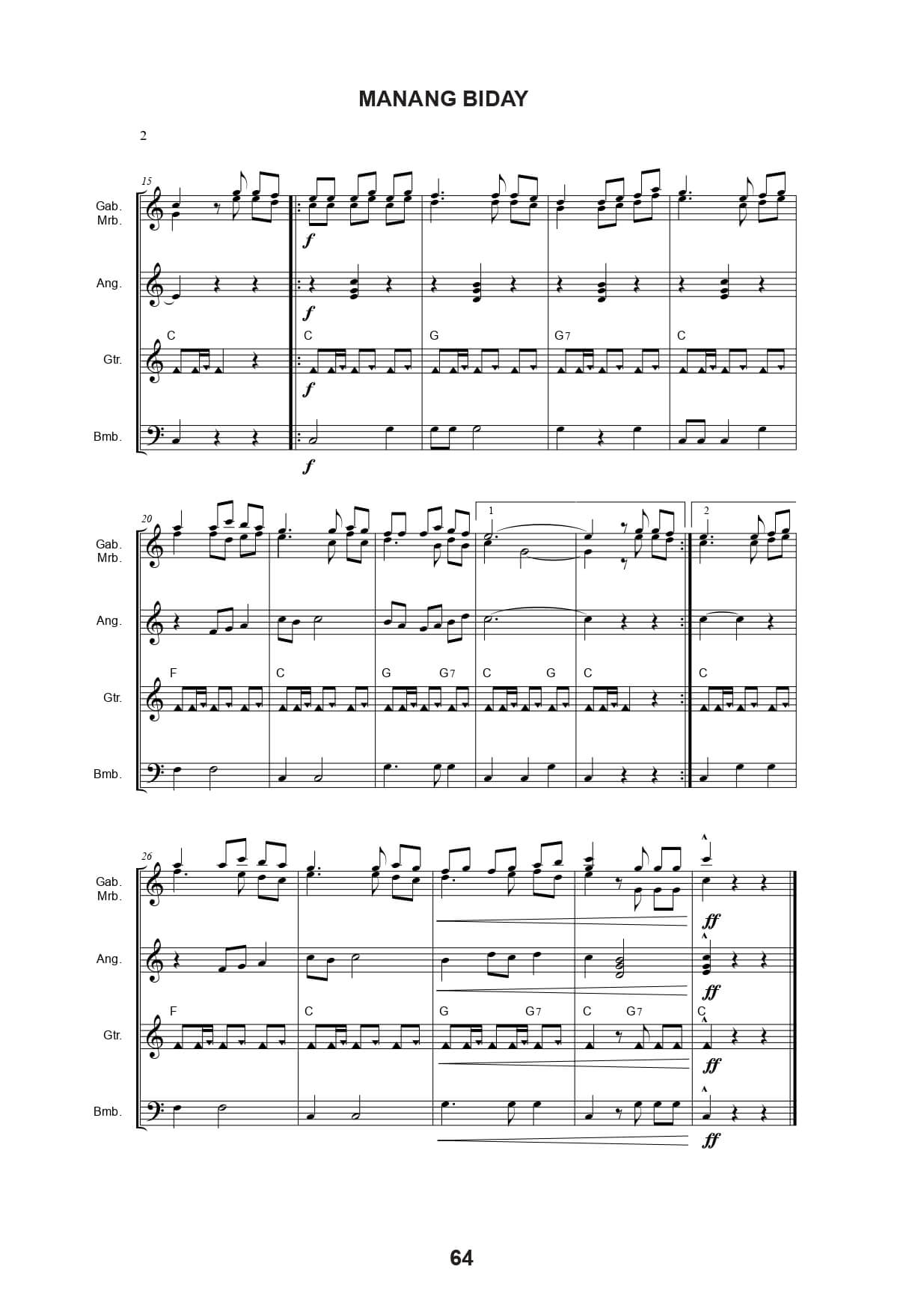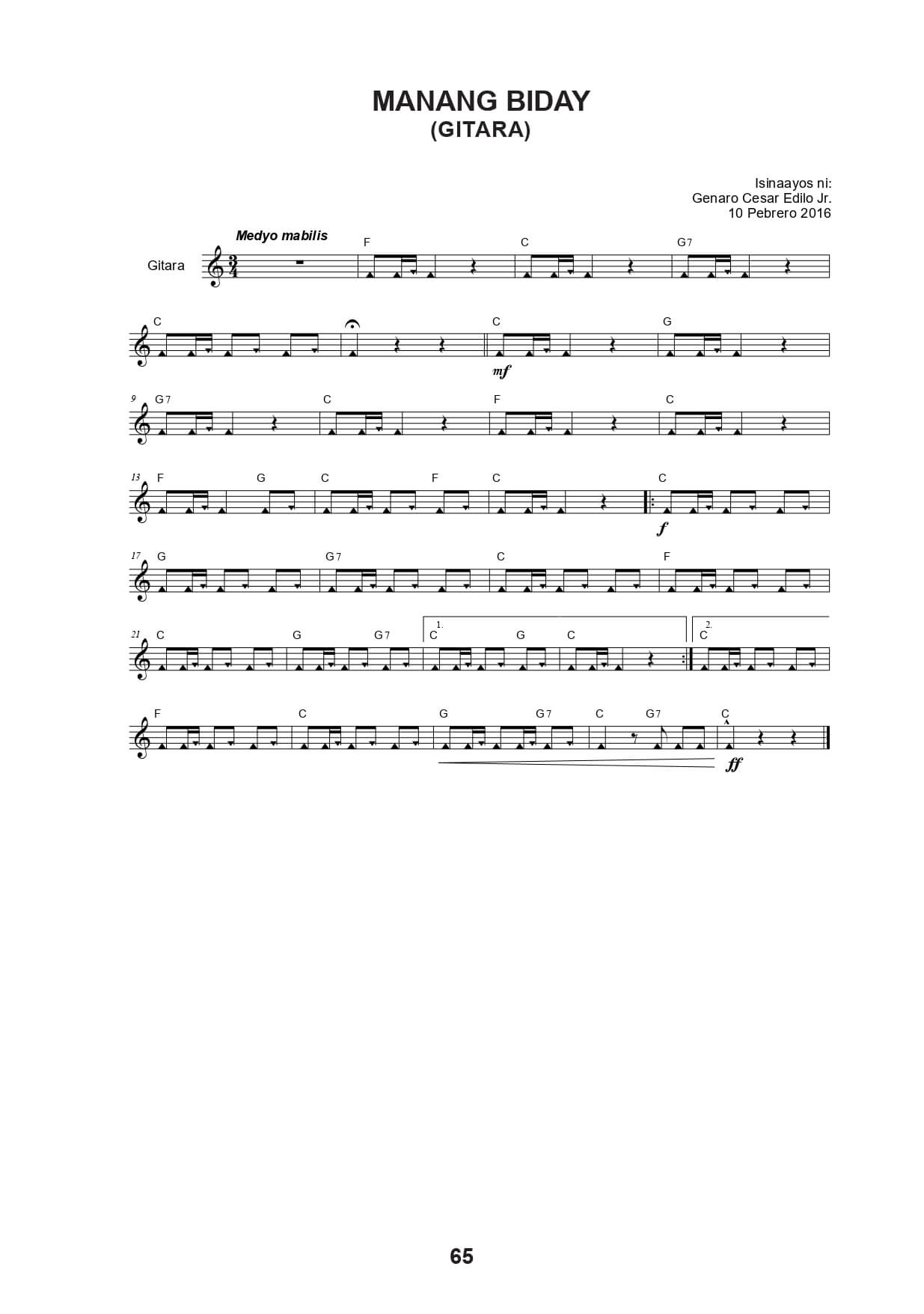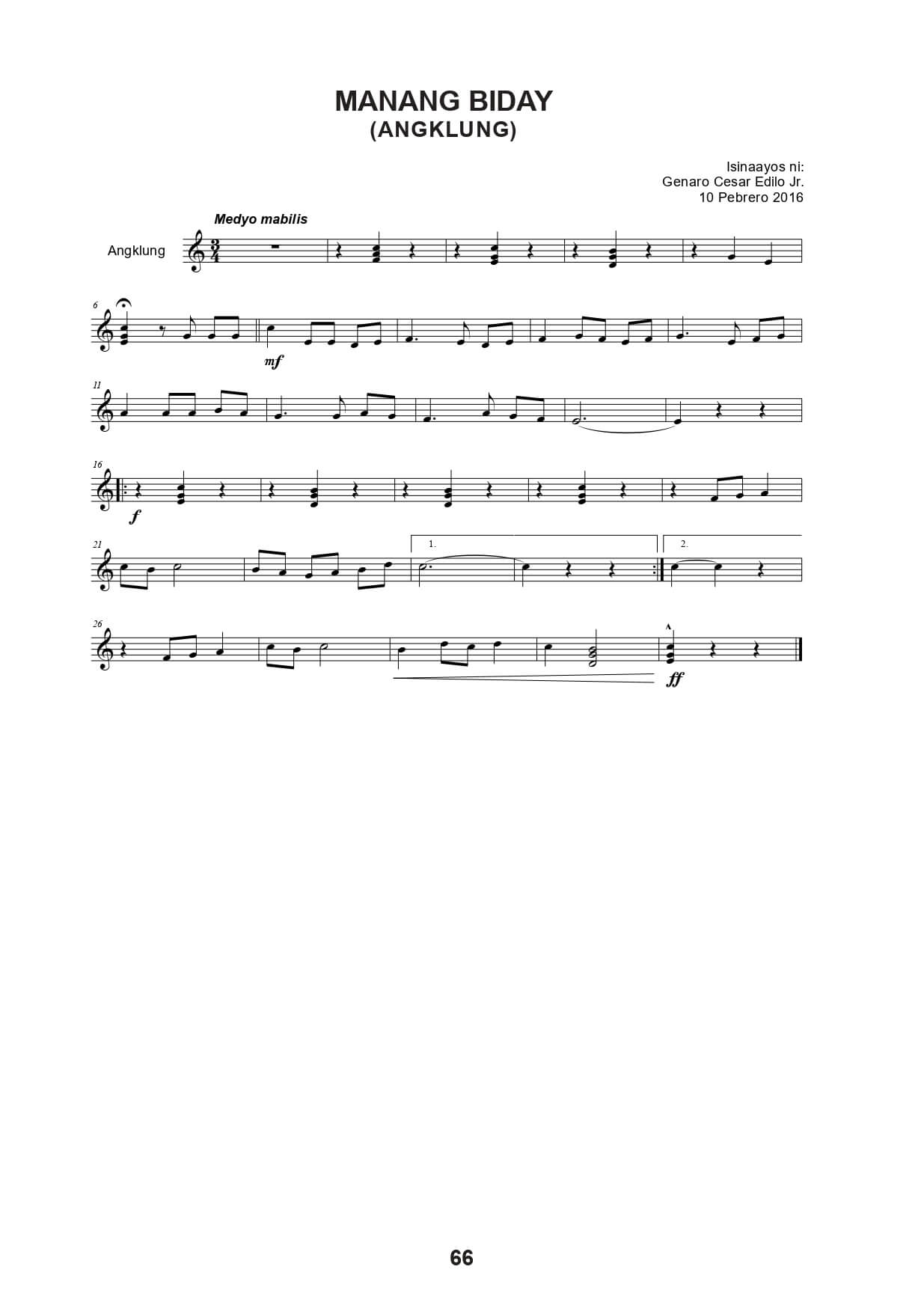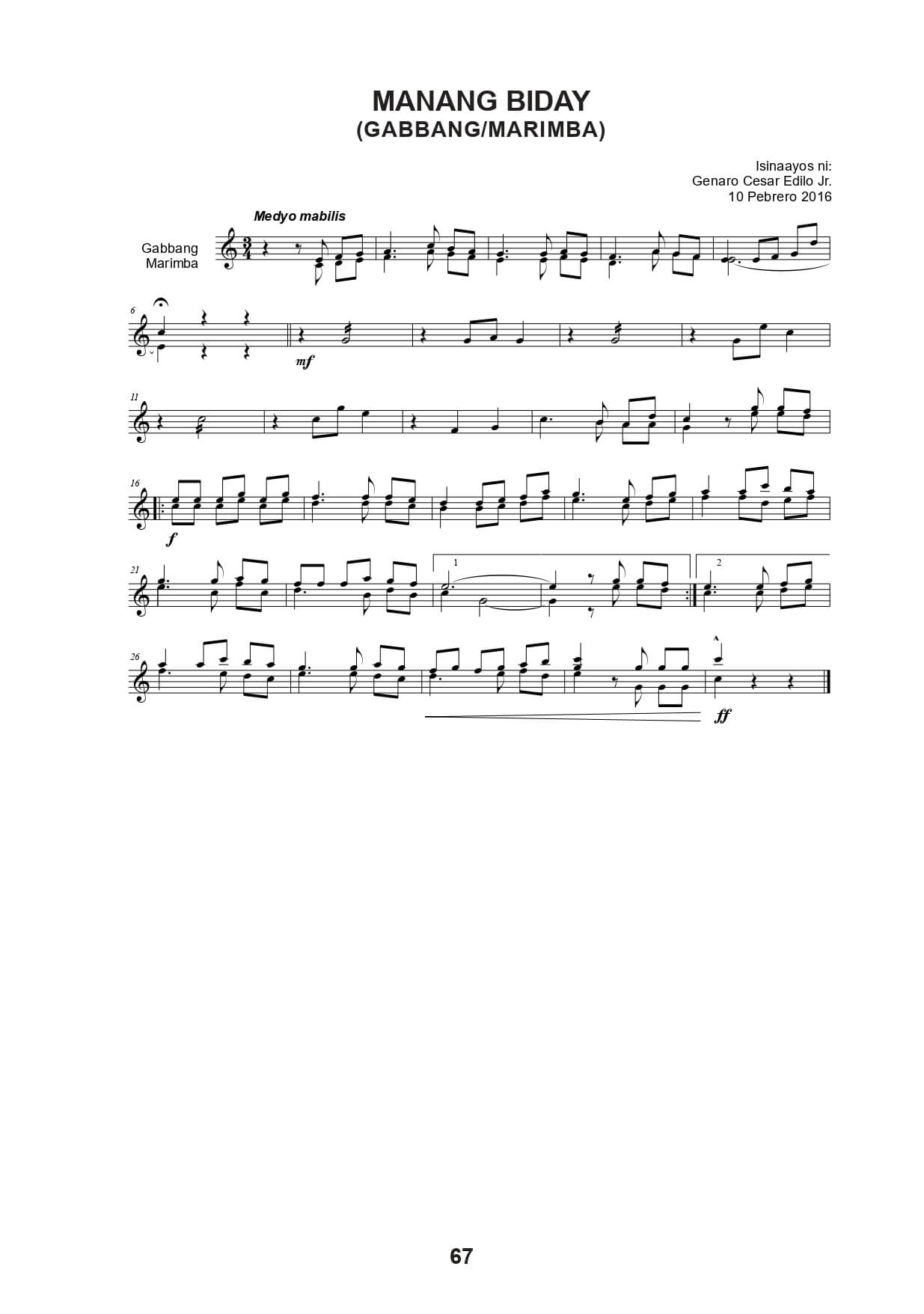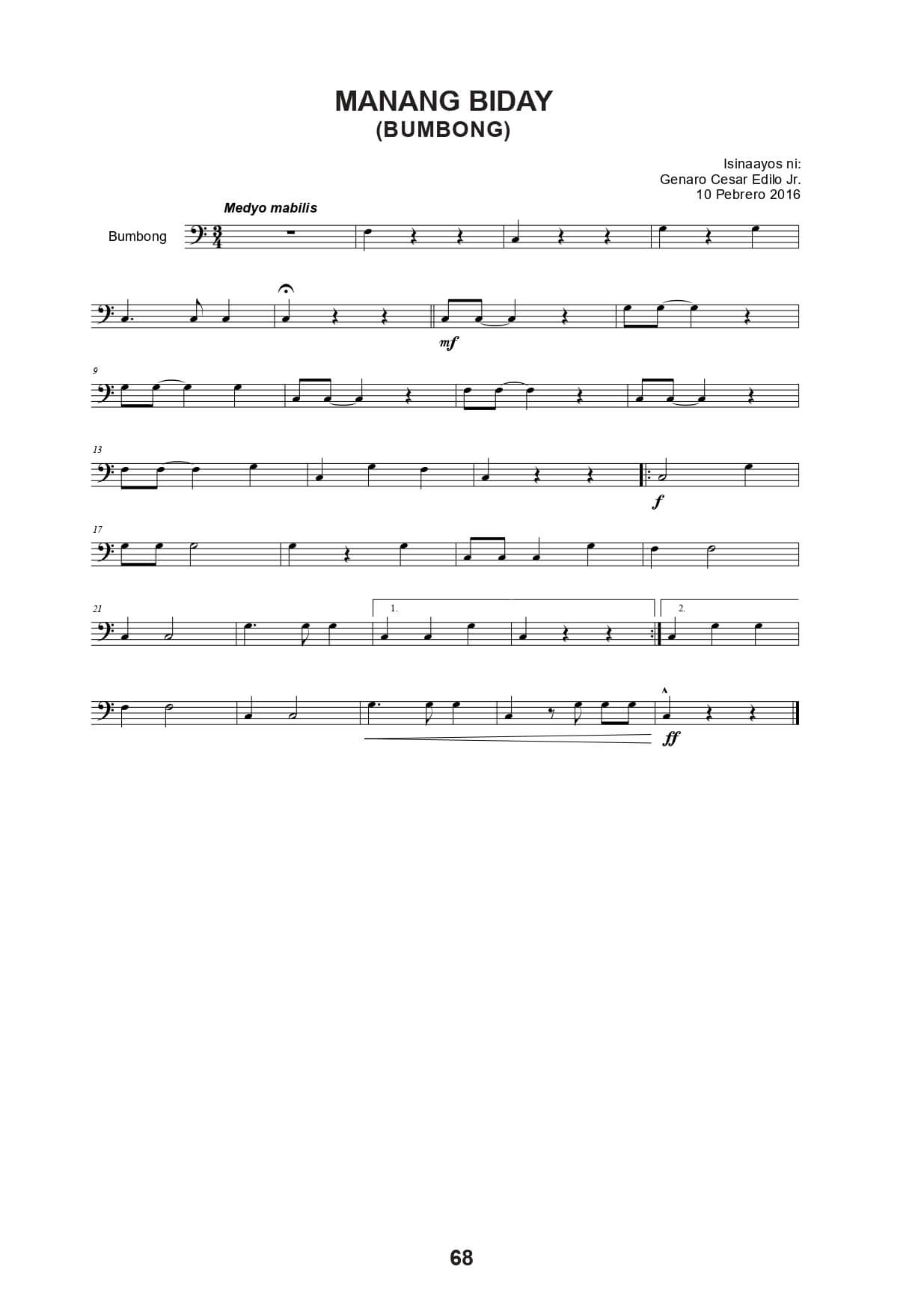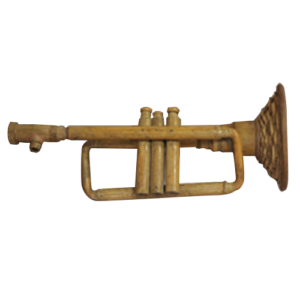Elementary Module
MANANG BIDAY REHEARSAL PLAN
- Volume 2
Background
Description: Ilokano Folk Song
Lyricist: Jose A. Bragado
Arranger: Genaro Cesar Edilo Jr., November 2015

Ilocano Lyrics
Manang Biday, ilukat mo man ‘Ta bintana ikalumbabam Ta kitaem ‘toy kinayawan
Ay, matayakon no dinak kaasian Siasinnoka nga aglabaslabas ‘Toy hardin ko pagay-ayamak Ammom ngarud a balasangak Sabong ti lirio, di pay nagukrad.
Denggem, ading, ta bilinenka Ta inkanto ‘diay sadi daya Agalakanto’t bunga’t mangga Ken lansones pay, adu a kita
No nangato, dika sukdalen No nababa, dimo gaw-aten No naregreg, dika piduten
Ngem labaslabasamto met laeng.
Daytoy paniok no maregregko Ti makapidut isublinanto Ta nagmarka iti naganko
Nabordaan pay ti sinanpuso.
Alaem dayta kutsilio
Ta abriem ‘toy barukongko Tapno maipapasmo ti guram Kaniak ken sentimiento.
“Manang Biday” is an Ilocano folk song about harana, the art of courtship through serenade. Harana songs were customarily sung by young men in hopes to court young, unmarried women. Like most folk songs, “Manang Biday” was composed during the Spanish colonial period of the Philippines as the song exhibits Spanish influence with Filipino indigenous sound and had been passed down through oral tradition. Around the 1930s and 1940s, harana songs became popular from all over the Philippines. Filipinos now hear harana songs on the radio. In Manila, recording companies started to take notice of the harana songs and decided to record it that eventually made harana songs popular among listeners.
In the song, there was also some kind or even fatherly guidance, which reminded the youth about responsibilities and priorities in one’s life. The song is persuading the listeners that there is a right moment for everything. For example, in courting someone, it is important to take things slowly and to wait instead of being in a hurry in answering “yes” or pressuring someone to acknowledge one’s love.
IV. PERFORMANCE GUIDE
A. MATERIALS
- Audio tracks – Scan QR code on the right

- Sheet music – Manang Biday arrangement by Genaro Cesar Edilo Jr.
B. GUIDE TO THE PIECE
There are 30 measures for this arrangement. The tempo is in allegretto. The angklung will play the melody starting on measure number 6. The marimba / gabbang will play the countermelody. The guitar will play the chords following the rhythmic pattern given. The bumbong will play the bass part of the arrangement.
V. REHEARSAL PLAN
| Time Allotment | Material | Instrument | Measures | Objective | Activity | Assessment | |
| 5
minutes |
marimba gabbang guitar angklung rambong | Prepare the members to play the instrument. | Arrange the instruments needed for the piece. | The members of the group will determine the needed tools for the rehearsal. | |||
| 15
minutes |
Warm up
/ Note Reading / Solfege |
marimba gabbang guitar angklung rambong | Prepare the members to play the piece. | Play legato, staccato etc. | The members of the group will execute the correct technique in playing. | ||
| 20
minutes |
Manang Biday | marimba gabbang | 1–30 | Recognize the rhythmic | Show skill in sight reading. | The members of the group will perform the correct patterns. | |
| patterns in the | |||||||
| song. | Demonstrate the clapping of the rhythmic pattern. | ||||||
| 20
minutes |
guitar | 1–30 | |||||
| 20
Minutes |
angklung | 1–30 | |||||
| 20
Minutes |
rambong | 1–30 |
| Time Allotment |
Material |
Instrument |
Measures |
Objective |
Activity |
Assessment |
| 20
Minutes |
By section | 1–15 | Precision in playing each part assigned.
Follow the given rhythmic pattern. |
Play the assigned instrument. | Repeat playing each assigned part on
the instrument as necessary. |
|
| Observe fermata. | ||||||
| Tremolo in measure 7, 9, 11 for gabbang / marimba. | ||||||
| Observe mezzo forte. | ||||||
| 20
Minutes |
By section | 16–24 | Show precision in playing each part assigned.
Follow the given rhythmic pattern. |
Play the assigned instrument. | Repeat playing each assigned part on
the instrument as necessary. |
|
| Observe forte in measure 16. | ||||||
| Observe the repeat marks / 1st and 2nd ending. | ||||||
| 20
Minutes |
By section | 25–30 | Show precision in playing each part assigned.
Follow the given rhythmic pattern. |
Play the assigned instrument. | Repeat playing each assigned part on
the instrument as necessary. |
|
|
Observe crescendo in measure 28 and fortissimo in measure 30. |
||||||
| 30
minutes |
marimba/ gabbang guitar angklung rambong | Perform the piece from beginning
to end without stopping.
Observe dynamics, tempo, and other musical marks on the piece. |
Show attentiveness in playing their parts.
Follow the conductor’s signal.
Deliver proper execution of dynamics. Show proper execution of dynamics. |
The members must make sure that all instruments are heard. The sound produced must be balanced for all instruments to be heard.If one cannot hear the other instruments played, it means one is playing very loud. |
No content.
No content.
No content.
No content.
No content.
No content.
Science in a creative industry.
The DOST-FPRDI has a Bamboo Musical Instruments Innovation R&D program aimed at improving the quality of locally-made bamboo musical instruments (BMIs) through science and innovative technologies. The program seeks to standardize the production of selected BMIs, develop prototype designs, analyze raw material sources and existing markets, and build a BMI processing facility. In addition, the program aims to document the ethnocultural story behind several BMIs and identify the bamboo species used in BMI production to promote public awareness and appreciation of the cultural importance of these musical instruments. The program is a collaboration with the University of the Philippines and Philippine Normal University for teaching modules and analyzing sound quality and standardization of BMI design. The DOST Grants-in-Aid program provides funding.
PhBMI

